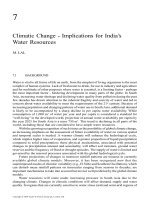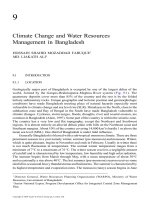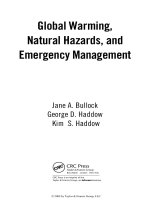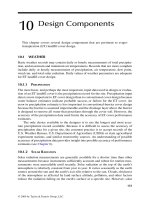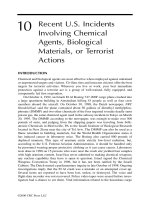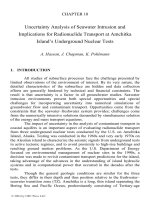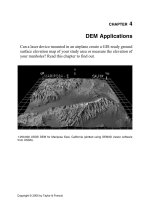GIS for Water Resources and Watershed Management - Chapter 10 docx
Bạn đang xem bản rút gọn của tài liệu. Xem và tải ngay bản đầy đủ của tài liệu tại đây (889.33 KB, 10 trang )
109
CHAPTER 10
Evaluation of the Albemarle-Pamlico
Estuarine Study Area Utilizing
Population and Land Use Information
Robert E. Holman
BACKGROUND
The Albemarle-Pamlico Estuarine Study (APES) has been funding many information acquisi-
tion projects over the last five years in the areas of resource critical areas, water quality, fisheries,
and human environment (Steel and Scully, 1991). Most of these projects have transferred their
data over to the APES’s Geographic Information System (GIS) which was created through a sub-
contract with the North Carolina Center for Geographic Information System (CGIA). GIS has the
ability to bring together (enter, display, edit, and manipulate) data based information with digital
mapping (locational attributes). At the time of this study, the Center (CGIA) had or was creating
all of the needed databases. CGIA was able to combine the data layers in various ways to analyze
the relationship among different layers in a visual as well as a statistical manner.
The study area encompasses approximately 23,250 square miles and includes all or portions of
37 counties in eastern North Carolina and 19 counties in Southeastern Virginia. There are six
counties along the coastline, 9 counties along the sounds, and 41 cities/counties that lie in the
upper drainage basin (Figure 10.1). This study also incorporates all or portions of 6 major river
basins including the Chowan, Pasquotank, Lower Roanoke, Tar-Pamlico, Neuse, and White Oak
(Figure 10.2). Each basin is divided into subbasins as follows: Chowan, 13; Pasquotank, 8; Lower
Roanoke, 3; Tar-Pamlico, 8; Neuse, 14; and White Oak, 5.
METHOD
The analytical method was broken into three phases. Phase One was the creation of county land
use maps from the existing Landsat classification scheme. These map products were sent to U.S.
Fish and Wildlife and county officials to determine the accuracy of the defined land use classes.
The land use maps were also used by the author during flights over the coastal and metropolitan
areas to further clarify classification errors. Phase Two was to correct some of the errors in the ex-
isting classification. This was carried out by digitizing the corrections to the map products that
were returned from Fish and Wildlife and county officials. The map information was also supple-
mented with other sources of information such as U.S. Fish and Wildlife Service—National Wet-
land Inventory, U.S. Forest Service—Forest Inventory and Analysis, U.S. Bureau of
Census—Census of Agriculture, and U.S. Soil Conservation Service—National Resources Inven-
tory and Hydric Soils in North Carolina counties. Phase Three was identifying correlation between
© 2003 Taylor & Francis
Chapters 1, 3, 5 & 6 © American Water Resources Association; Chapter 13 ©
Elsevier Science; Chapter 14 © American Society for Photogrammetry and Remote Sensing
110 GIS FOR WATER RESOURCES AND WATERSHED MANAGEMENT
different data sets such as county census population and county acreage of developed land. If a
strong correlation was found, then a simple linear regression model was applied in order to predict
the relationship between the two parameters. These models were used to correct some of the errors
in specific land use categories.
Map Development
There were three tasks in the development of land use and population estimates for the entire
APES area: (1) defining the actual drainage area; (2) having all the basin and subbasin boundaries
digitized in order to determine the land use and population; and (3) correcting for errors associated
with the different land uses.
First, the study area was defined as the entire drainage area of the Albemarle and Pamlico
Sound system including Core and Bogue Sounds. The upper Roanoke Basin and a portion of the
White Oak Basin were not included because: (1) the upper Roanoke River Basin covers approxi-
mately 8,370 square miles in Virginia/North Carolina and stretches over two-thirds the length of
North Carolina, and would add one-third more area to the study area; and (2) a decision was made
early in APES to have Carteret County as the furthest area south. However, due to the watershed
approach in defining the study area in this project, all the subbasins in the White Oak Basin were
included except the furthest one southwest that starts at Camp Lejeune. There was no compatible
land use data available for this subbasin.
Figure 10.1. Map of study area.
© 2003 Taylor & Francis
Chapters 1, 3, 5 & 6 © American Water Resources Association; Chapter 13 ©
Elsevier Science; Chapter 14 © American Society for Photogrammetry and Remote Sensing
EVALUATION OF THE ALBEMARLE-PAMLICO ESTUARINE STUDY AREA 111
Second, all North Carolina basins and subbasins were digitized by the Research Triangle Insti-
tute and compared closely with the U.S. Geological Survey subbasins for North Carolina. Virginia
subbasin information was supplied by Information Support Systems Laboratory within Virginia
Polytechnic Institute and State University and was based on Soil Conservation Service (SCS) in-
formation. Due to the large number of subbasins identified by SCS in the Virginia portion of the
Chowan and Pasquotank Basins, subbasins were combined to create areas of the same size range
as subbasins identified in North Carolina. All subbasins were digitized from U.S. Geological Sur-
vey’s 1:24,000 scale topographic maps. Specific subbasins were identified by a six number code
that was broken into two-digit sets. The first two digits identified the regional basin; the second
two digits identified the basin; and the third two digits identified the subbasin (Figure 10.2). Codes
used in this report were the same ones adopted by the North Carolina Division of Environmental
Management.
The third task was to identify the accuracy of the land use data and to develop methods to cor-
rect for the errors. Khorram and others (1992) found that with the Landsat data, the urban or built-
up land use category was only 46% accurate, and the accuracy of forested wetlands was unknown.
In addition, the classification of mixed pixels in the existing land use data set had to be resolved.
Mixed pixels are defined as areas that could not be classified because the resolution or pixels were
a mixture of many categories. The land use classification from 1987–1988 developed by Khorram
will be referred to as the “Landsat” classification in this study.
Figure 10.2. The six APES basins and their subbasins.
© 2003 Taylor & Francis
Chapters 1, 3, 5 & 6 © American Water Resources Association; Chapter 13 ©
Elsevier Science; Chapter 14 © American Society for Photogrammetry and Remote Sensing
Accuracy and Errors
The first task was to define which level of land use to utilize. Landsat land use classification
defined 18 separate classes that can be generally broken into similar U.S. Geological Survey level
I and level II groupings (Anderson and others, 1976). The land use classification was based on
Landsat data which Khorram interpreted mostly as land cover (the actual extent of vegetative and
other cover) and some land use (interpretation of activities taking place on the land). Interpretation
of land use is much more subjective than land cover and is dependent on the knowledge of the in-
dividual interpreter.
A level II map with 18 individual classes was provided to officials of two Fish and Wildlife
Refuges within the APES area for their evaluation as to land cover accuracy. The Great Dismal
Swamp National Wildlife Refuge staff reviewed the Landsat land use map of the refuge. This
refuge, located on the border between North Carolina and Virginia just south of Portsmouth, Vir-
ginia covers approximately 110,000 acres and is predominantly forested wetland. The staff felt
there was good separation among development, agriculture, water, and forest; however, the differ-
ent forest cover types had serious reliability problems. A major problem was the misclassification
of wetter deciduous stands like cypress/gum and maple/gum as pine/hardwood forest. A second
land cover map was sent to Mattamuskeet and Swan Quarter National Wildlife Refuges personnel
for their review. These two refuges are located entirely in Hyde County, North Carolina, and Swan
Quarter is adjacent to the Pamlico Sound. These refuges together cover approximately 65,700
acres and are predominantly water, wetland, and forest. The staff found quite a few areas that were
referred to as mixed pixels that were actually open water and irregularly flooded brackish marshes.
White Cedar stands were actually marsh impoundment areas around Lake Mattamuskeet, and pine
forest was actually mixed pine/hardwood or hardwood/cypress/pine forest. In general, both
refuges indicated accuracy problems with the different forest and the mixed pixel classifications.
After indicating they could not evaluate all the classifications in level II land cover maps, offi-
cials of counties in the Currituck Sound Basin south of Virginia Beach and adjacent to the Atlantic
Ocean were sent, for comment, land cover maps which included the following attributes: USGS
level I with 6 categories shown in color; U.S. Census TIGER files that displayed the road network,
map scale of 1:100,000; and modified LUDA land use data for the urban or built-up category.
Land Use Data Analysis (LUDA) was an early GIS effort started by U.S. Geological Survey in
1975 to define the land use for the entire United States. All the photographs were manually pho-
tointerpreted. The map series consisted of 1:250,000 scale maps of North Carolina defining 37
uses based on the level II classification system. Source imagery was 1:56,000 color infrared pho-
tography and 1:80,000 black and white photography dating back to 1970. Resolution was 10 acres
for the urban or built-up categories and 40 acres for the remaining classifications (Kleckner,
1981). For comparison, the Khorram classification was based on 1987–1988 Landsat satellite im-
agery that was semiautomatically interpreted. The county map series was at a scale of 1:100,000
with a final resolution of 1 acre.
In 1991 and 1992, the author flew along the Outer Banks and inland around the estuarine por-
tion of the study area and over portions of Wake, Durham, and Orange Counties to verify the prob-
lems with the categories of urban or built-up, wetland, and mixed pixels. The urban or built-up
class was underestimated on the 1987–1988 land use maps mainly due to forest crown cover that
obscured the true land use on the ground. High spectral reflectance of bare agricultural fields was
also a problem because these fields were being classified as developed areas. The problem with
fields being identified as developed areas was especially evident in the Landsat scene furthest west
that included the Raleigh metropolitan area. This category was a very small percentage (3.3 to
112 GIS FOR WATER RESOURCES AND WATERSHED MANAGEMENT
© 2003 Taylor & Francis
Chapters 1, 3, 5 & 6 © American Water Resources Association; Chapter 13 ©
Elsevier Science; Chapter 14 © American Society for Photogrammetry and Remote Sensing
7.9%) of the overall land use of the study area but is critical in that urban or built-up land use can
cause the greatest impact on natural resources of the APES area.
Problems associated with the wetland class were found to be interference from forest crown
cover. Open marsh and pocosin wetlands were usually accurately defined by the 1987–1988 land
use maps but closed forest canopy prevented standing water below the forest to be seen. Therefore
these true wetland types were usually defined as forest.
The category of mixed pixels is a grouping the classification scheme could not identify. Flights
over the coastal and metropolitan areas verified that in most cases they were a mixture of standing
water and wetland vegetation. The only exception to this observation was in Pasquotank County
where poorly drained agricultural land was defined as mixed pixels or wetland on the county land
use map.
These land use classification problems and others were identified in a workshop the author at-
tended to verify remotely sensed land cover data for the Coastwatch Change Analysis Program of the
National Oceanic and Atmospheric Administration (Burgess and others, 1992). The problems fell
into four categories: classification error, cover versus land use, categorical resolution, and change de-
tection. Classification errors included “salt and pepper” effect of individual pixels, shadows and bare
ground as urban areas, and problems with the degree of wetness during image acquisition. Cover ver-
sus land use had the inherent problem with distinguishing land uses and required ancillary data. Cat-
egorical resolution was related to the spatial resolution and improper classification. The change
detection problem involved the ability to detect a change but not always the nature of the change.
From the author’s own observations and the results of this workshop, methods were developed to
overcome some of the problems associated with remotely sensed land cover data.
Land use information used in this study was analyzed according to the Khorram and others
(1992) classification system but condensed from 18 to 7 categories. Certain corrections were in-
corporated into some classes depending on the observed and documented error associated with
each class. The LUDA data set was used to determine “developed land” because the information
appeared to be closer to the actual extent and location than the original 1987–1988 Landsat data
set. Corrected Landsat built-up areas on the maps returned by county officials were found to have
a high degree of correlation (R
2
of 0.9) with the LUDA “developed” category. A linear regression
model was used to predict built-up land from the LUDA data. U.S. Fish and Wildlife’s National
Wetland Inventory (NWI) data were used as a reliable source of wetland acreage for the coastal
plains of North Carolina (Wilen, 1990 and Burgess and others, 1992). Wetland acres for twelve of
the coastal counties was provided by Kevin Morehead of the Savannah River Ecology Laboratory.
The same procedure used to correct built-up areas was used to reconcile the Landsat wetland cat-
egory with the NWI acreage. A high correlation resulted with a R-squared of 0.9 and a simple lin-
ear regression model was used to predict wetland acres from the NWI values. The mixed pixel
unidentified category was determined by the U.S. Fish and Wildlife personnel and two overflights
of the APES area to be predominantly wetland in nature. The mixed pixel figures were incorpo-
rated into the wetland classification.
RESULTS
Land Use
The entire APES area land use classification is based on a modified U.S. Geological Survey’s
level I classification scheme. One fact to keep in mind is that the water class is not a true land use
but is a very important classification. There were seven classes with the following percentages:
“urban” 4.8%, “agriculture” 28.2%, “forest” 28.4%, “water” 14.6%, “wetland” 20.5%, “shrub
EVALUATION OF THE ALBEMARLE-PAMLICO ESTUARINE STUDY AREA 113
© 2003 Taylor & Francis
Chapters 1, 3, 5 & 6 © American Water Resources Association; Chapter 13 ©
Elsevier Science; Chapter 14 © American Society for Photogrammetry and Remote Sensing
114 GIS FOR WATER RESOURCES AND WATERSHED MANAGEMENT
land” 3.3%, and “barren land” 0.2% (Figure 10.3). In general, the study area is rural in nature with
less than 5% of the total area developed. More than 55% of the total APES acreage came from the
categories of agriculture and forest.
Population
The population of the study area was almost 2 million people (Figure 10.4). About 51.2% re-
side in the Neuse Basin, which occupies only 26.8% of the land area. Population density for the
basins ranged from 163.1 persons/square mile in the Neuse to 39.9 persons/square mile in the
Chowan. Since the population density of all but two basins fell below the U.S average of 69 per-
sons/square mile, most of the study area can be characterized as nonmetropolitan (U.S. Bureau of
Census 1960, 1970, 1980, 1990).
Population Versus Developed Land
When the subbasins with the highest number of persons/square mile are compared to the sub-
basins that have the greatest amount of developed land there appears to be a great deal of agree-
ment. If a strong correlation exists between these two parameters then a powerful planning tool
can be created to predict the amount of developed land from the existing or projected population
for a certain area.
The APES area has only two comprehensive land use databases and one does not correlate
well with the category of urban or built-up land. Therefore, another source of long-term land use
Figure 10.3. APES 1990 land use/land cover.
© 2003 Taylor & Francis
Chapters 1, 3, 5 & 6 © American Water Resources Association; Chapter 13 ©
Elsevier Science; Chapter 14 © American Society for Photogrammetry and Remote Sensing
EVALUATION OF THE ALBEMARLE-PAMLICO ESTUARINE STUDY AREA 115
data is needed to determine if the relation between population and developed land is statistically
sound. Land use data from the State of Maryland has been gathered since 1973 and has been
taken as frequently as every five years during the past 15 year period (Maryland State Planning
Office, 1991). The acres of total developed land were compared to the closest population census
data for each county in Maryland. Three periods (1973, 1981, and 1990) had correlation with a
R
2
value of greater than or equal to 0.9. A simple regression model was developed for each cor-
relation and the results were very similar for all three periods. A population of 200,000 people
was equated to between 39,000 and 43,000 acres of developed land. Since this relationship held
for the Maryland data set, could the same relationship be established with the limited land use
data sets in North Carolina? The earlier LUDA data set appeared to correlate well with devel-
oped land, but how could the existing Landsat accuracy for developed land be improved? Land-
sat land use maps of 21 counties in the APES area were sent out to county planners or other
county officials for their review. Each county official was to shade in the extent of development
that took place in his county during 1990 and change any land use that was not properly classi-
fied. The returned maps were digitized and new acreage for developed land was obtained for
each county. Both the LUDA and the corrected Landsat land use maps were compared to the
population census data in the same manner as the Maryland information. Both correlation had a
R
2
value of greater than or equal to 0.8. Again, a simple linear regression model was developed
for each correlation and the results were very similar for both 1970 and 1990 (Figures 10.5 and
10.6). A population of 200,000 people was equated to between 45,000 and 60,000 acres of de-
veloped land.
A statistical relationship between population census and developed land for the same time
frame has been established for land area in Maryland and the APES area. The relationship is not
the same for both areas and probably will vary from region to region. Based on this relationship
Figure 10.4. APES basin populations in 1990.
© 2003 Taylor & Francis
Chapters 1, 3, 5 & 6 © American Water Resources Association; Chapter 13 ©
Elsevier Science; Chapter 14 © American Society for Photogrammetry and Remote Sensing
116 GIS FOR WATER RESOURCES AND WATERSHED MANAGEMENT
the number of acres of developed land for the years 1970, 1980, and 1990 has been estimated
for each of the six basins in the APES area. The resulting pattern is similar to that of population,
with the Neuse Basin having the largest amount of developed land over the last 30 years. The
1990 figures show the Neuse Basin with approximately 306,000 acres of developed land and the
Figure 10.5. 1970 population vs 1972 land use.
Figure 10.6. 1990 population vs 1990 land use.
© 2003 Taylor & Francis
Chapters 1, 3, 5 & 6 © American Water Resources Association; Chapter 13 ©
Elsevier Science; Chapter 14 © American Society for Photogrammetry and Remote Sensing
EVALUATION OF THE ALBEMARLE-PAMLICO ESTUARINE STUDY AREA 117
White Oak Basin with the least at 65,000 acres of developed land. Developed land for the entire
study area for 1990 was approximately 597,000 acres based on this predictive method. Projec-
tions for the year 2000 and 2010 (NCDC, 1991; VEC, 1991) have also been estimated and com-
pared to the year 1990. Developed land for the entire study area for the year 2010 is
approximately 752,000 acres based on this predictive method. The Neuse River Basin continues
to have the most developed land with 407,000 acres and the White-Oak Basin has the least with
26,000 acres (Figure 10.7). The Pasquotank Basin appears to have outpaced the Chowan Basin
in the amount of developed land and contains the third largest acreage behind the Neuse and
Tar-Pamlico.
CONCLUSIONS
This study found that land use data from Landsat was not adequate by itself to properly identify
seven land use classifications. The greatest errors appeared to be associated with the classes of
built-up and wetlands. This was due to the forest crown cover obscuring the true land use of rural
residential development on the ground and data sources combined with existing data sets in the
form of a linear regression appeared to compensate for these two major errors.
A high correlation between population and developed land was found on a county level from
Maryland, Virginia, and North Carolina data. Based on this correlation a linear regression model
was developed to predict the number of acres of developed land based on the projected population
for a particular county. The relation between population and developed land will not be the same
for each region but this method can be a powerful tool in predicting where and how development
will take place in a particular county.
Figure 10.7. Developed land in basins.
© 2003 Taylor & Francis
Chapters 1, 3, 5 & 6 © American Water Resources Association; Chapter 13 ©
Elsevier Science; Chapter 14 © American Society for Photogrammetry and Remote Sensing
118 GIS FOR WATER RESOURCES AND WATERSHED MANAGEMENT
REFERENCES
Anderson, J.R., E.E. Hardy, J.T. Roach, and R.E. Witmer, 1976. A Land Use and Land Cover Clas-
sification System for Use with Remote Sensor Data. U.S. Department of the Interior, U.S. Ge-
ological Survey Professional Paper 964. U.S. Geological Survey. Washington, D.C.
Burgess, W., E. Christoffers, J. Dobson, R. Ferguson, A. Frisch, P. Lade, and J. Thomas, 1992. Re-
sults of a Field Reconnaissance of Remotely Sensed Land Cover Data. Maryland Department
of Natural Resources. Annapolis, MD.
Khorram, S., H. Cheshire, K. Sideralas, and Z. Nagy, 1992. Mapping and GIS Development of
Land Use and Land Cover Categories for the Albemarle-Pamilco Drainage Basin. Albemarle-
Pamlico Estuarine Study. Project No. 91-08. North Carolina Department of Environment,
Health, and Natural Resources. Raleigh, NC.
Kleckner, R., 1981. A National Program of Land Use and Land Cover Mapping and Data Compi-
lation. In Planning Future Land Use, American Society of Agronomy, Special Publication No.
42.
Maryland State Planning Office, 1991. Maryland’s Land 1973–1990: A Changing Resource. Balti-
more, MD.
North Carolina Data Center (NCDC), 1991. Population Projections for the Years 2000 and 2010.
Raleigh, NC.
Steel, J., and M. Scully, 1991. Projects Funded by the Albemarle-Pamlico Estuarine Study. Albe-
marle-Pamlico Estuarine Study. Project No. 91-00. North Carolina Department of Environ-
ment, Health, and Natural Resources. Raleigh, NC.
Virginia Employment Commission (VEC), 1991. County Population Projections for the Years
2000 and 2010. Richmond, VA.
Wilen, B.O., 1990. The U.S. Fish and Wildlife Service’s National Wetland Inventory. In Federal
Coastal Wetland Mapping Programs: A Report by the National Ocean Pollution Policy Board’s
Habitat Loss and Modification Working Group. Kiraly, S.A. and F.A. Cross, Eds., U.S. Depart-
ment of the Interior. Washington, D.C.
© 2003 Taylor & Francis
Chapters 1, 3, 5 & 6 © American Water Resources Association; Chapter 13 ©
Elsevier Science; Chapter 14 © American Society for Photogrammetry and Remote Sensing

